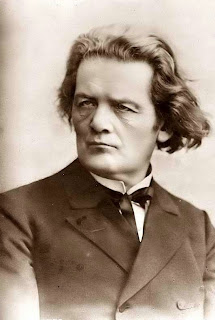Information
Composer: Anton Rubinstein
CD1:
- (01-04) Piano Sonata No. 1 in E minor, Op. 12
- (05-08) Piano Sonata No. 2 in C minor, Op. 20
CD2:
- (01-04) Piano Sonata No. 3 in F major, Op. 41
- (05-07) Piano Sonata No. 4 in A minor, Op. 100
Leslie Howard, piano
Recording Date: 1980 (Nos. 1 & 3), 1981 (Nos. 2 & 4)
Release Date: 1996
Label: HyperionRelease Date: 1996
http://www.hyperion-records.co.uk/dc.asp?dc=D_CDD22007
-----------------------------------------------------------
Reviews
It is hard to understand why this music never found a place in the repertoire; the Third and Fourth Sonatas, in particular, contain some highly effective, if eccentric, piano writing. Edward Garden in Grove intimates that it was Rubinstein's carelessness that barred him from achieving greater quality as a composer—certainly there are many awkward elements in these large-scale works, but these do not really obscure the strength of purpose behind the writing. Leslie Howard understands Rubinstein's range of temperament very well indeed and I cannot think of another pianist whose advocacy could have been more persuasive.
Anton Rubinstein was born in the Ukraine; he was of Judaeo-German extraction. Together with his younger-brother, Nikolay, he was taken around Europe as a child prodigy. Between 1844 and 1846, whilst living in Berlin, he came to know Mendelssohn. It was the latter who most influenced his style, as can be heard right from the beginning of the First Sonata. In certain respects one might say that it is the imprint of Mendelssohn's orchestral works, rather than those for piano, that is evident in the 18-year-old composer's writing. Alkan comes to mind as well—the left hand interjections and the interspersed accents in the Scherzo from the First Sonata are reminiscent of the Frenchman—although this may be coincidence. In this work the finale is much the longest movement, but there is quite a bit of writing here that sounded to me like a good reduction of an orchestral score.
The Second Sonata dates from about five years later. In the first movement the contrapuntal writing is rather didactic, but Howard plays with such authority and enthusiasm that one is willingly caught up in the music. The second movement is a Theme and Variations. The first two numbers are curiously unambitious as piano writing, whereas the third, which is more light-hearted, is individual and fresh. A near-quote from Schumann's Kreisleriana finds its way into this item. The work ends with a predictably stormy minor key movement.
Apparently, the Third Sonata of 1853–4 was Rubinstein's own favourite and he included it complete in his legendary ''Historical Recitals'' of the 1880s. A noticeable feature in his compositions is that the second subjects of movements usually contain the most memorable material and this is the case here. The virtuoso writing has developed somewhat from the earlier two pieces, quite possibly under the influence of Henselt's playing and compositions. The Scherzo in march rhythm—terse in mood and economical in notation—is one of the best things the composer ever wrote. There is an Alkanesque starkness that is highly effective, although again devices deriving from orchestral style are apparent. In the slow movement one hears music that must have had a strong impact on the young Tchaikovsky. The coda of the fourth has some very taxing passages, which Howard negotiates with terrific elan.
The last Sonata contains elements from Schumann's Fantasy and G minor Sonata, as well as Chopin's ''Funeral March'' Sonata, and an amazing energy abounds. The Scherzo has a most peculiar mixture of whimsy and bombast. It is perhaps an impression of the composer's vehemence that is the strongest feeling left by the music. Considerably later than the other three, the Fourth Sonata was composed around 1880, when Rubinstein was at the height of his powers as a pianist.
Considering that both Rubinstein's style as a composer and Howard's as a performer are rather on the large side, it is remarkable how successful the actual recording is. The piano sound is wholly acceptable and in the Second and Fourth Sonatas, recorded nearly a year after the other two, the piano tone is especially vivid.
-- James Methuen-Campbell, Gramophone
More reviews:
http://www.amazon.com/Complete-Piano-Sonatas-A-Rubinstein/dp/B000002ZED
-----------------------------------------------------------

Anton Grigorevich Rubinstein (November 28 [O.S.November 16] 1829 – November 20 [O.S. November 8] 1894) was a Russian pianist, composer and conductor who became a pivotal figure in Russian culture when he founded the Saint Petersburg Conservatory. He was the elder brother of Nikolai Rubinstein who founded the Moscow Conservatory. As a pianist, Rubinstein ranks amongst the great 19th-century keyboard virtuosos. Rubinstein was also a prolific composer throughout much of his life.
http://en.wikipedia.org/wiki/Anton_Rubinstein
http://en.wikipedia.org/wiki/Anton_Rubinstein
***
Leslie Howard (born 29 April 1948) is an Australian pianist and composer. He is best known for being the only pianist to have recorded the complete solo piano works of Franz Liszt, a project which included more than 300 premiere recordings. In addition to his Liszt project, Leslie Howard's recordings include works by many other composers.
http://en.wikipedia.org/wiki/Leslie_Howard_(musician)
http://en.wikipedia.org/wiki/Leslie_Howard_(musician)
-----------------------------------------------------------
FLAC, tracks
Links in comment
Enjoy!


This comment has been removed by the author.
ReplyDeleteCD1
DeleteMEGA
http://adf.ly/1Hgzsm
CD2
MEGA
http://adf.ly/1Hgzso